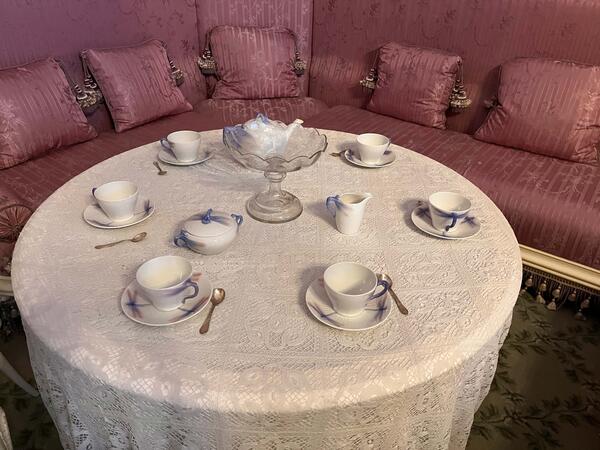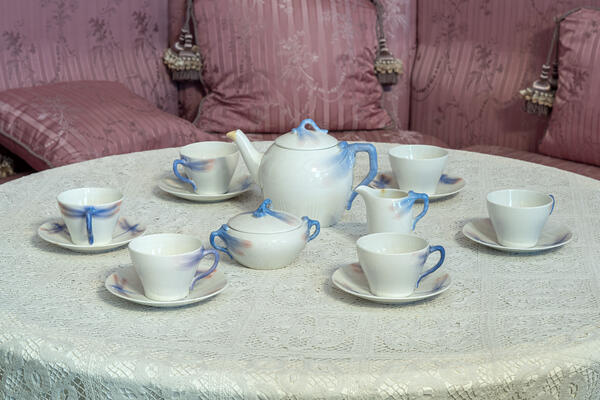The Dragonfly tea-and-coffee set comes from the Mauve Room of the Alexander Palace. The service has a smooth white surface decorated with several rows of fine grooves as well as a relief image of lilac and pink dragonflies. These fragile insects were one of the most popular decorative elements of Art Nouveau works.
The set was created at the Rörstrand factory outside Stockholm. This Swedish factory was founded in 1726 on the initiative of the artist-ceramist Johann Wolf from Nuremberg as an earthenware factory of the Stockholm Chamber of Commerce. During the 18th and 19th centuries, the factory produced porcelain works of high artistic standard following the mainstream styles.
The creator of all the items in the set of the Mauve Room is the distinguished Swedish artist Alf Wallander, who made a great contribution to the formation of decorative and applied art in the Art Nouveau style. Wallander worked in the field of artistic ceramics, glass, metal, furniture and textiles. Between 1879 and 1885, he studied at the National College of Arts, Crafts and Design in Stockholm. He continued his studies at the Swedish Royal Academy of Arts between 1888 and 1895, and between 1885 and 1889 at the Académie Moreau and Constant in Paris. In 1900, he became artistic director of the factory in Rörstrand, where he worked until 1914 as a designer of models and decors, remaining one of the leading masters of the enterprise. In 1900, he was awarded the Grand Prix at the World Exhibition in Paris.
For the Dragonfly tea-and-coffee set, Alf Wallander was able to find his own original way of decorating it, turning the curved bodies of dragonflies into the grip of the lids as well as the handles of the cups, teapots, creamer and sugar bowl.
The influence of Danish porcelain art was reflected in the use of underglaze painting. The color palette of the Swedish masters was dominated by light celadon, deep blue, velvety black and purple. The artistic production of the Swedish factory was characterized by the inseparable unity of plastic and pictorial decoration. Painted plants softly transform into relief decoration, turning into a wreath of buds. Flexible bodies of sea animals, birds, figurines of insects twine around objects, as if growing out of them.
The set was created at the Rörstrand factory outside Stockholm. This Swedish factory was founded in 1726 on the initiative of the artist-ceramist Johann Wolf from Nuremberg as an earthenware factory of the Stockholm Chamber of Commerce. During the 18th and 19th centuries, the factory produced porcelain works of high artistic standard following the mainstream styles.
The creator of all the items in the set of the Mauve Room is the distinguished Swedish artist Alf Wallander, who made a great contribution to the formation of decorative and applied art in the Art Nouveau style. Wallander worked in the field of artistic ceramics, glass, metal, furniture and textiles. Between 1879 and 1885, he studied at the National College of Arts, Crafts and Design in Stockholm. He continued his studies at the Swedish Royal Academy of Arts between 1888 and 1895, and between 1885 and 1889 at the Académie Moreau and Constant in Paris. In 1900, he became artistic director of the factory in Rörstrand, where he worked until 1914 as a designer of models and decors, remaining one of the leading masters of the enterprise. In 1900, he was awarded the Grand Prix at the World Exhibition in Paris.
For the Dragonfly tea-and-coffee set, Alf Wallander was able to find his own original way of decorating it, turning the curved bodies of dragonflies into the grip of the lids as well as the handles of the cups, teapots, creamer and sugar bowl.
The influence of Danish porcelain art was reflected in the use of underglaze painting. The color palette of the Swedish masters was dominated by light celadon, deep blue, velvety black and purple. The artistic production of the Swedish factory was characterized by the inseparable unity of plastic and pictorial decoration. Painted plants softly transform into relief decoration, turning into a wreath of buds. Flexible bodies of sea animals, birds, figurines of insects twine around objects, as if growing out of them.




